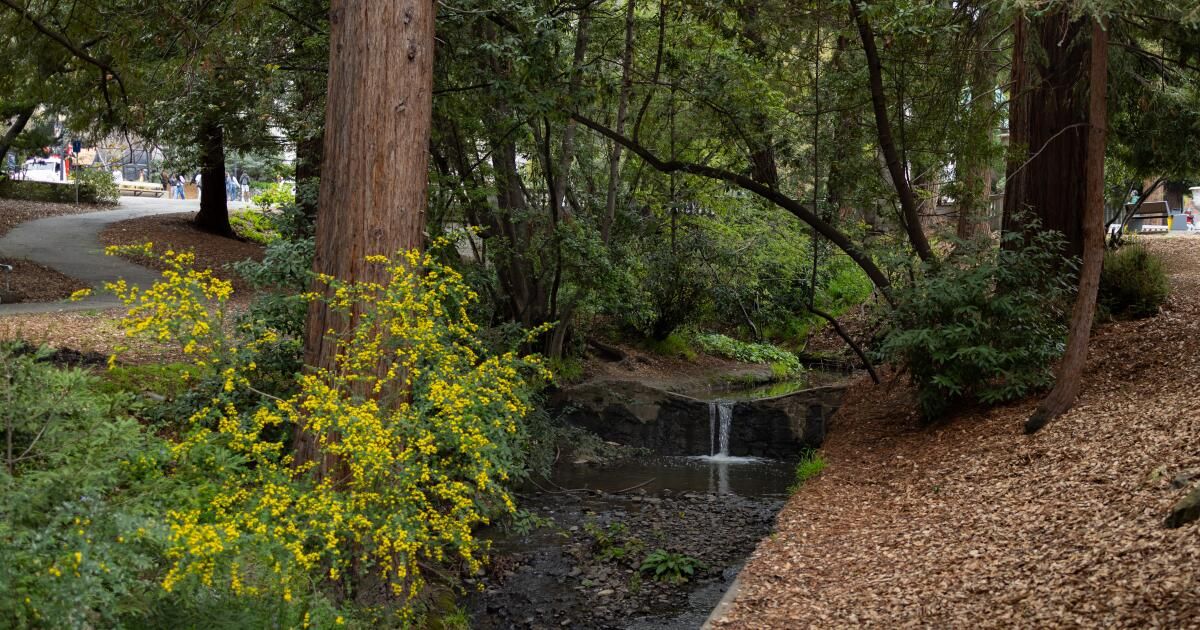A few months ago, while visiting the roof bar in an Inn residence in Berkeley, I picked up the brilliant “Visitors' Guide” of the city and looked for it in the historical pepitas that this type of publications invariably include.
“For thousands of years before the local arrival of the Europeans,” I read, “Berkeley, and all East's bay, was the home of the speech Ohlone Chochenio. The specific area of Berkeley current was known as Huchiun.”
It is not so bad for a public relations gift, except that a few millennia then jumped at a speed speed to the appearance of the Spaniards at the end of 1700, the discovery of gold (1848), the foundation of the University of California in Berkeley (1873) and the movement of freedom of expression and summer of love in the sixties, which, according to the guide, endoned the city with the city with the city with the city. Original thought “and summer”.
I have spent most of the last five years digging in the past of California to expose the role of UC on the wrong side of history, in particular the history of American natives. From the beginning of the twentieth century, Berkeley academics (and in the USC and Huntington Library) played a central role in the configuration of the public cultural identity of the state. They wrote textbooks and popular stories, consulted with amateur journalists and historians, and generated a semi -official narrative that represented indigenous peoples as frozen in time and irresponsible administrators of the Earth. His version of the history of California reinvented the earth and the massacres as progress and popularized the fiction that the natives disappeared silently in the past premoderno.
Today, promoted by new research and an indigenous organization, tribal groups and a later generation of historians have worked to make things clear. For thousands of years, the California tribes and the land in which they lived prospered, the result of creative adaptation to changing circumstances.
When the Spanish and American colonizers conquered the West, the tribal groups resisted. In fact, the State was one of the most bloody regions in the country in the nineteenth century, worthy of a vocabulary that we generally associate with other countries and other times: pogroms, ethnic cleaning, apartheid, genocide. Despite this devastation, the population of California today includes more than 100 tribes and ranches.
Very few details of the authentic history of the history of Precalifornia in our public spaces, our common cultural knowledge. Instead, I have become a collector of the retrospective fantasies that we consume: those few sentences in the Berkeley visitors guide, Google, made in menus, fragments on maps and parks' brochures, which is recorded in a million wall plates and greased on road markers. These are the places where most people find historical narratives and where history acquires the patina of truthfulness.
One Sunday, while I waited for an order from the ethereal lemon-icota pancakes in Oceanside Denn on Fourth Street in Berkeley, I read some history in the menu. The neighborhood, he said, was created in the early 1850s, when workers and farmers developed a shopping center: a mill mill, soap factory, blacksmith and a inn. It was not mentioned that the restaurant occupied an Ohlone site that flourished for 2,000 to 3,000 years, part of a network of interrelated communities that extended from the San Francisco Bay, crossing what is now the Berkeley Campus and following a cannon and a fresh fluid stream towards the hills.
A friend who knows that I like Rye whiskey recently gave me a bottle of Redwood Empire. The Worddy label explains that whiskey is named “a scarcely populated area” in northern California characterized by a “often inaccessible coast soaked for fog, rocky cliffs and steep mountains” and “home of coastal dry majestic.” It is a place “where you can connect with nature”, but apparently not with the tribes that make it your home now and have done so since time immemorial.
Traditional travel guides omit the most worrying information and emphasize California as an example of diversity and prosperity. The old days are blamed to the Franciscan missionaries who, according to the 1997 ocular witness travel guide for the State, “used the natives as cheap labor” already “European settlers who committed a more serious crime by spreading diseases that would reduce the native population to approximately 16,000 in 1900”. This unstable story jumps the crimes of Americans and lands in the mid -twentieth century, when Native Americans may be surprised at knowing: “They opted for integration throughout the state.”
The guides have become more hips, although they are still mainly ahistoric. The “California field guide” of Wildsam, for example, includes “there” by Tommy Orange (Oakland, born, Arapaho and Cheyenne) in its list of mandatory reading fiction, provides a detailed LGBTQ+ chronology, covers Chez Panisse and the Black Panther Party, but also reduces indigenous history to indigenous history to the indigenous history 1400s. [when] Various native tribes bloom. “
UC Berkeley's botanical garden, with “one of the largest collections of Native California plants in the world,” is located in Strawberry Canyon, the route followed by Ohlone generations to hunting land in the hills. There are no plates in the 34 Acres park recognizing the past prior to California of the site and no book in the gift store educates visitors about what contemporary environmentalists are learning from indigenous land management practices, such as prescribed burns and selective harvest.
The gaps created by the tendency to present the origins of California on the sunny side cushion curiosity and pollute a basic understanding of US history.
For example, Lawrence's Hall of Science, a teaching laboratory for Berkeley students and a public science center, has initiated a project to “promote a clear understanding of the experiences of the people of Ohlone.” Unfortunately, dodges the role of the university to systematically looted indigenous tombs in California and appropriate the ancestral burial land in Los Alamos, NM, where UC Berkeley had a role in the creation of the atomic bomb.
Similarly, almost all of the campus know the history of manifestations of freedom of expression, but almost no one knows about the longest and continuous protest movement in the state, and one is still strongly freed against the university: the struggle to repatriate ancestral remains and cultural objects that began in the 1900s when Yokayo's operations, according to local media accounts, the lawyers of the media, the lawyers of the media, the lawyers of the media, the lawyers of the media, the lawyers of the media, the lawyers of the media, the lawyers of the media. Wide “to the Ranchos de la Ranchas Istales”. [Cal] Scientists in the vicinity of Ukiah. “
Even activists in the bay area are not immune to this amnesia. In April, I participated in a demonstration on the Berkeley campus to protest the devastating Trump administration attacks against the academy. The main speakers, who represented a variety of departments (ethnic studies, African -American studies, Latin studies, Asian -American studies and humanities) defended the importance of anti -racism education and testified the long history of students' protests on the Berkeley campus. What was missing was not only the inclusion of an American native speaker, but also any reference to the looting of indigenous sites that was inseparable from the material and cultural bases of the university.
I remember the warning of the main judge of the Tribal Court of Yurok Abby Abinanti: “The most difficult mistakes to correct are those that are entrenched.”
Out of history, out of mind.
Tony Platt is a scholar at the UC Berkeley Law and Society Study Center. He is the author of “Serious Matters: The Controverssy for digging the buried indigenous past of California” and more recently, “the lime scandal.”










